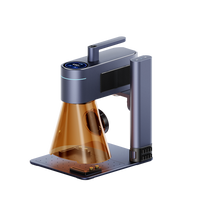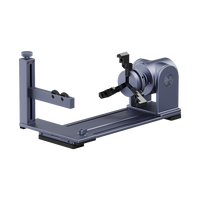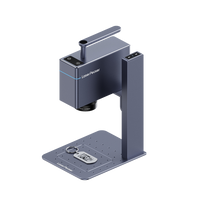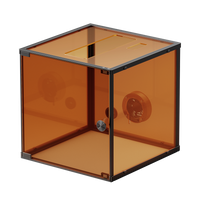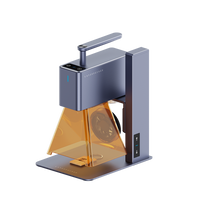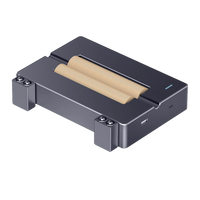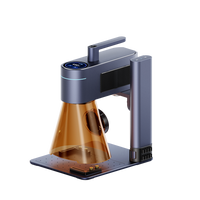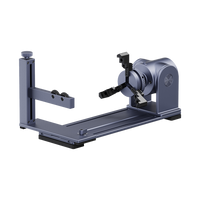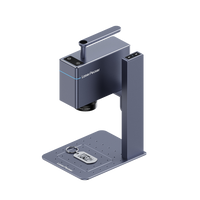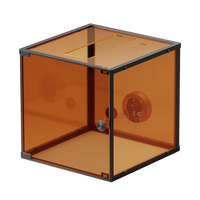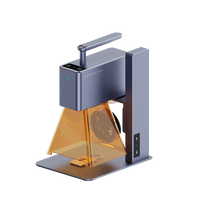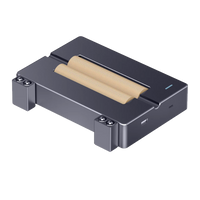Engraved glass make great personalized presents. Whether it's a custom set of wine glasses, a beer mug adorned with their name and a significant emblem, or any other personalized touch, it showcases the effort you've put into the present.
Picture yourself drinking from an engraved glass with a custom design of your choice, enjoying relaxing moments alone or with friends. In this blog, we will delve into top 5 methods to engrave glass, exploring the tools needed and detailed steps for each method.
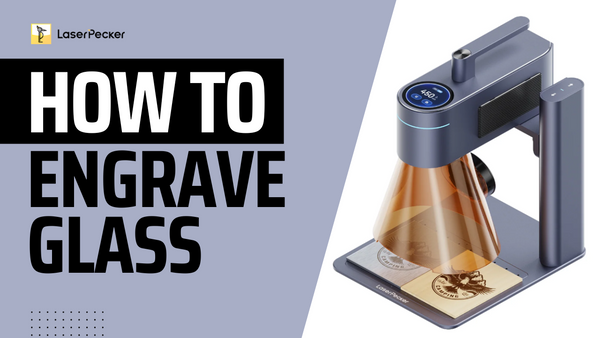
In this article:
Method 1: How to Laser Engrave Glass
Laser engraving on glass is a highly precise method of etching designs, patterns, text, or images onto glass surfaces using a concentrated laser beam. It's a versatile technique used for creating personalized gifts, decorative items, signage, and more due to its ability to produce intricate and detailed results on glass objects.
Tools Needed for Laser Engraving Glass
Glass Laser Engraving Machine: A portable yet powerful laser engraving machine like LaserPecker 4 specifically designed for working with glass.
Design Software: Create or import designs into the LaserPecker engraving machine's software for customization.
Personal Protective Equipment (PPE): Use safety goggles and Laser Protection Cover to ensure safety while working with the laser.
Masking Materials: Tape or specialized masking products to protect specific areas of the glass during engraving.
Cleaning Supplies: Isopropyl alcohol, microfiber cloths, and other cleaning materials for post-engraving cleanup.
How to Laser Engrave Glass
Step 1 - Design Creation or Import: Create the desired design using computer-aided design (CAD) software or import existing designs into the engraving machine's software.
Step 2 - Prepare the Glass: Clean the glass surface thoroughly to ensure there are no particles or residue that could interfere with the engraving process. Apply masking materials to protect areas not meant to be engraved.
Step 3 - Set Up the Engraving Machine: Configure the laser engraving machine with the appropriate settings, including laser power, speed, frequency, and focus, based on the design and type of glass being used.
Step 4 - Engrave the Glass: Initiate the engraving process, ensuring that the machine accurately follows the designated design to etch onto the glass surface. Monitor the process to ensure precision and quality.
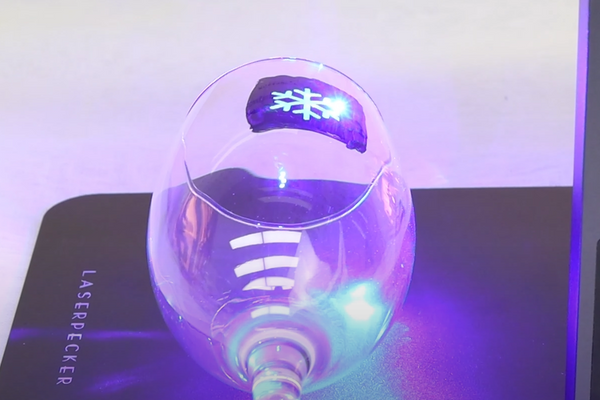
Step 5 - Post-Engraving Cleaning: Once the engraving is complete, remove the masking materials and clean the glass thoroughly with isopropyl alcohol or a similar cleaning agent to eliminate any residues or particles resulting from the engraving process.
Step 6 - Finishing Touches (Optional): Apply finishes or coatings to enhance the appearance or durability of the engraved design, if desired.
Video Guide on Laser Engraving Glass
Method 2: How to Engrave Glass by Hand (Carving)
Hand engraving, or carving, on glass involves using manual tools to etch designs, patterns, or text onto glass surfaces. This traditional method allows for artistic freedom and personalized detailing, creating unique and intricate designs on glassware, ornaments, and decorative items.
Tools Needed for Hand Engraving Glass
Diamond Burrs: Small, specialized tools with diamond-coated tips used for carving and engraving on glass. Available in various shapes and sizes for different engraving effects.
Pin Vise or Rotary Tool: Hand-held devices used to hold and maneuver diamond burrs for precise engraving on glass surfaces.
Masking Materials: Tape or protective film to cover areas on the glass not meant for engraving, safeguarding them from accidental carving.
Cleaning Supplies: Isopropyl alcohol, microfiber cloths, or glass cleaner for cleaning the glass before and after engraving.
Personal Protective Equipment (PPE): Safety goggles and gloves to protect against glass particles and for overall safety while working.
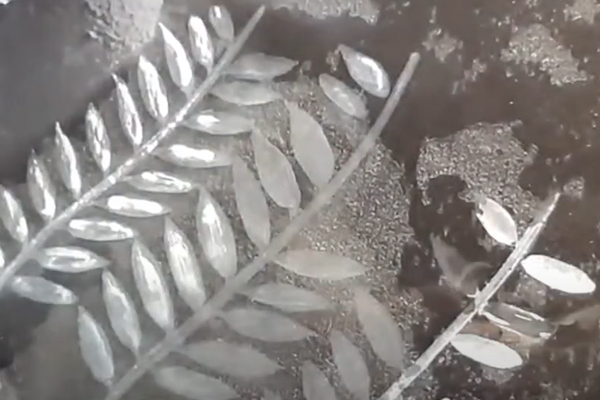
How to Engrave Glass by Hand
Step 1 - Design Preparation: Decide on the design to be engraved on the glass and sketch it out on paper. This helps visualize the design before starting the engraving process.
Step 2 - Prepare the Glass: Clean the glass surface thoroughly to remove any dirt, oil, or residues. Apply masking materials to protect areas not intended for engraving.
Step 3 - Select Diamond Burr and Tool: Choose the appropriate diamond burr for the desired engraving effect and insert it into the pin vise or rotary tool.
Step 4 - Engrave the Glass: With the selected tool and burr, gently and steadily carve the design onto the glass surface. Control the pressure applied to achieve varying depths and intricacies in the engraving.
Step 5 - Clean the Engraved Glass: After completing the engraving, remove the masking materials and clean the glass surface to eliminate any debris or particles resulting from the carving process.
Step 6 - Finishing Touches (Optional): Optionally, apply a protective coating or finish to the engraved area to enhance the design's visibility or durability.
Video Guide on Hand Engraving Glass
Method 3: How to Engrave Glass with A Dremel
Engraving glass with a Dremel involves using a rotary tool to etch designs, patterns, or text onto glass surfaces. The Dremel, a versatile handheld tool with various attachments, allows for precision and control in creating personalized and intricate engravings on glassware, mirrors, and decorative items.
Tools Needed for Engraving Glass with a Dremel
Dremel Rotary Tool: A high-speed, handheld rotary tool equipped with engraving attachments suitable for glass engraving.
Diamond Burr or Engraving Bits: Specialized attachments with diamond-coated tips designed for engraving on glass surfaces.
Masking Materials: Tape or protective film to cover areas on the glass not intended for engraving, safeguarding them from accidental etching.
Cleaning Supplies: Isopropyl alcohol, microfiber cloths, or glass cleaner for cleaning the glass before and after engraving.
Personal Protective Equipment (PPE): Safety goggles and gloves to protect against glass particles and ensure safety while working with the Dremel.
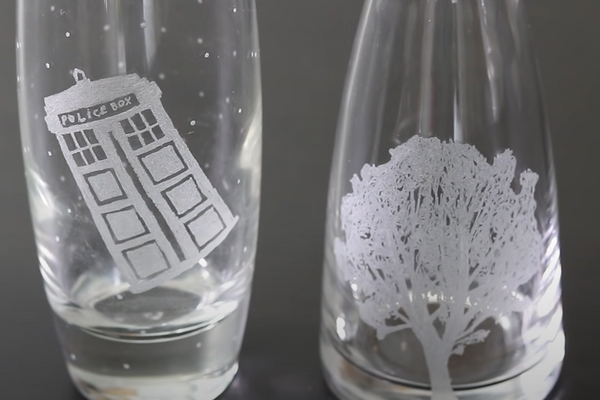
How to Engrave Glass with a Dremel
Step 1 - Design Preparation: Determine the design or pattern to be engraved on the glass surface. Create a sketch or stencil to guide the engraving process.
Step 2 - Prepare the Glass: Clean the glass thoroughly to remove any dirt, oil, or residues. Apply masking materials to protect areas not intended for engraving.
Step 3 - Attach Diamond Burr or Engraving Bit: Select the appropriate engraving attachment and securely attach it to the Dremel rotary tool.
Step 4 - Engrave the Glass: Utilize the Dremel tool with the selected engraving bit to delicately and methodically etch the chosen design onto the glass surface. Manage the tool's speed and pressure applied for optimal control and accuracy in creating the desired depth and intricacy in the engraving.
Step 5 - Clean the Engraved Glass: Upon completion of the engraving process, remove the masking materials and meticulously cleanse the glass surface. This step ensures the removal of any residual debris or particles resulting from the etching procedure.
Step 6 - Finalize the Engraving (Optional): As a concluding step, consider applying a protective coating or finishing touch to the engraved area, enhancing both the visibility and durability of the design as desired.
Video Guide on Engraving Glass with a Dremel
Method 4: How to Engrave Glass with Cricut Maker
Engraving glass with a Cricut Maker involves using a specialized tool called the "Engraving Tip" along with the Cricut machine to etch designs, patterns, or text onto glass surfaces. This method provides precision and customization, allowing users to create intricate and personalized engravings on various glass items such as vases, mirrors, or glassware.
Tools Needed for Engraving Glass with Cricut Maker
Cricut Maker: A cutting machine that supports the use of the Engraving Tip and is compatible with the Design Space software.
Engraving Tip: A specialized tool designed for use with the Cricut Maker to engrave designs onto materials like glass.
Masking Material: Tape or adhesive vinyl to cover areas on the glass surface not intended for engraving, protecting them from the etching process.
Cleaning Supplies: Isopropyl alcohol, microfiber cloths, or glass cleaner for cleaning the glass before and after engraving.
Personal Protective Equipment (PPE): Safety goggles for eye protection during the engraving process.

How to Engrave Glass with Cricut Maker
Step 1 - Design Preparation: Create or select the design or pattern to be engraved using the Cricut Design Space software. Ensure the design is compatible with the Engraving Tip and sized appropriately for the glass item.
Step 2 - Prepare the Glass: Clean the glass surface thoroughly to remove any dust, fingerprints, or residues that could interfere with the engraving. Apply masking material to cover areas not intended for engraving.
Step 3 - Set Up the Cricut Maker: Install the Engraving Tip into the Cricut Maker machine and load the chosen design into the Design Space software, following the provided instructions.
Step 4 - Adjust Settings: Within the Design Space software, adjust the settings for the material (glass) and the Engraving Tip. Ensure the correct settings for depth, pressure, and speed are selected for optimal engraving results.
Step 5 - Engrave the Glass: Place the prepared glass item onto the Cricut Maker's cutting mat and securely attach it. Initiate the engraving process, allowing the machine to precisely etch the design onto the glass surface.
Step 6 - Clean the Engraved Glass: Once the engraving is completed, carefully remove the masking material and thoroughly clean the glass surface to eliminate any debris or residues from the engraving process.
Video Guide on Engraving Glass with Cricut Maker
Method 5: How to Engrave Glass through Sandblasting
Sandblasting is a technique used to engrave or etch designs onto glass surfaces by propelling abrasive materials at high speeds. This method allows for precise and intricate detailing, creating frosted or textured designs on glassware, windows, mirrors, and other glass items.
Tools Needed for Engraving Glass through Sandblasting
Sandblasting Machine: Equipment that propels abrasive materials such as sand, aluminum oxide, or silicon carbide at high pressure onto the glass surface.
Abrasive Material: Fine-grit materials used for sandblasting, such as sand or other abrasives suitable for glass etching.
Stencil or Masking Material: Stencils or masking materials (vinyl, adhesive-backed film, or specialized stencils) to cover areas on the glass not intended for etching, protecting them from the abrasive particles.
Air Compressor: Provides the necessary air pressure to propel the abrasive material through the sandblasting machine onto the glass surface.
Personal Protective Equipment (PPE): Safety goggles, gloves, and a respirator to protect against abrasive particles and ensure safety during sandblasting.

How to Engrave Glass through Sandblasting
Step 1 - Design Creation or Selection: Create or choose the design or pattern intended for engraving on the glass surface. Convert the design into a stencil or masking format suitable for sandblasting.
Step 2 - Prepare the Glass: Clean the glass thoroughly to remove any dust, fingerprints, or residues. Apply the stencil or masking material to cover areas not meant for etching.
Step 3 - Set Up the Sandblasting Equipment: Load the abrasive material into the sandblasting machine's reservoir. Ensure the machine is connected to the air compressor and adjust the pressure settings as needed.
Step 4 - Glass Engraving: Position the prepared glass item in the sandblasting cabinet or area. Use the sandblasting machine to direct the abrasive material onto the exposed glass surface through the stencil or masking, creating the desired engraved design.
Step 5 - Remove Stencil and Clean: Once the engraving is completed, carefully remove the stencil or masking material from the glass surface. Clean the glass thoroughly to eliminate any abrasive residue or particles.
Video Guide on Engraving Glass through Sandblasting
FAQs About Glass Engraving
1. Can I engrave colored or tinted glass?
Engraving on colored or tinted glass is possible, but the visibility of the engraving may vary depending on the glass's transparency and color. Generally, engravings on clear glass tend to be more visible compared to heavily tinted or colored glass.
2. Can any type of glass be engraved?
While most types of glass can be engraved, some may be more suitable than others. Soda-lime glass, for instance, is commonly used due to its composition and transparency. However, tempered glass or extremely thin glass may be more challenging to engrave due to their properties.
3. What types of glass items can be engraved?
Glass items suitable for engraving include glassware (such as wine glasses, tumblers, and mugs), decorative glass pieces, mirrors, windows, awards, ornaments, and more. Essentially, any glass surface that allows for engraving can be utilized.
4. How to engrave glass at home?
Many glass engraving techniques can be done at home with the right tools and safety precautions. Hand engraving, for example, using a Dremel, Cricut Maker or mini laser engraving machine, can be done in a controlled environment with proper equipment and techniques.
Conclusion
In conclusion, engraving glass at home offers a diverse range of techniques. Preparation, precision, and safety are crucial, starting with a clean glass surface and proper masking. Practice and patience are key to mastering this craft, emphasizing safety precautions throughout.
Ultimately, this creative process enables the crafting of unique, personalized pieces, showcasing the beauty of engraved glass in various artistic and decorative applications.






